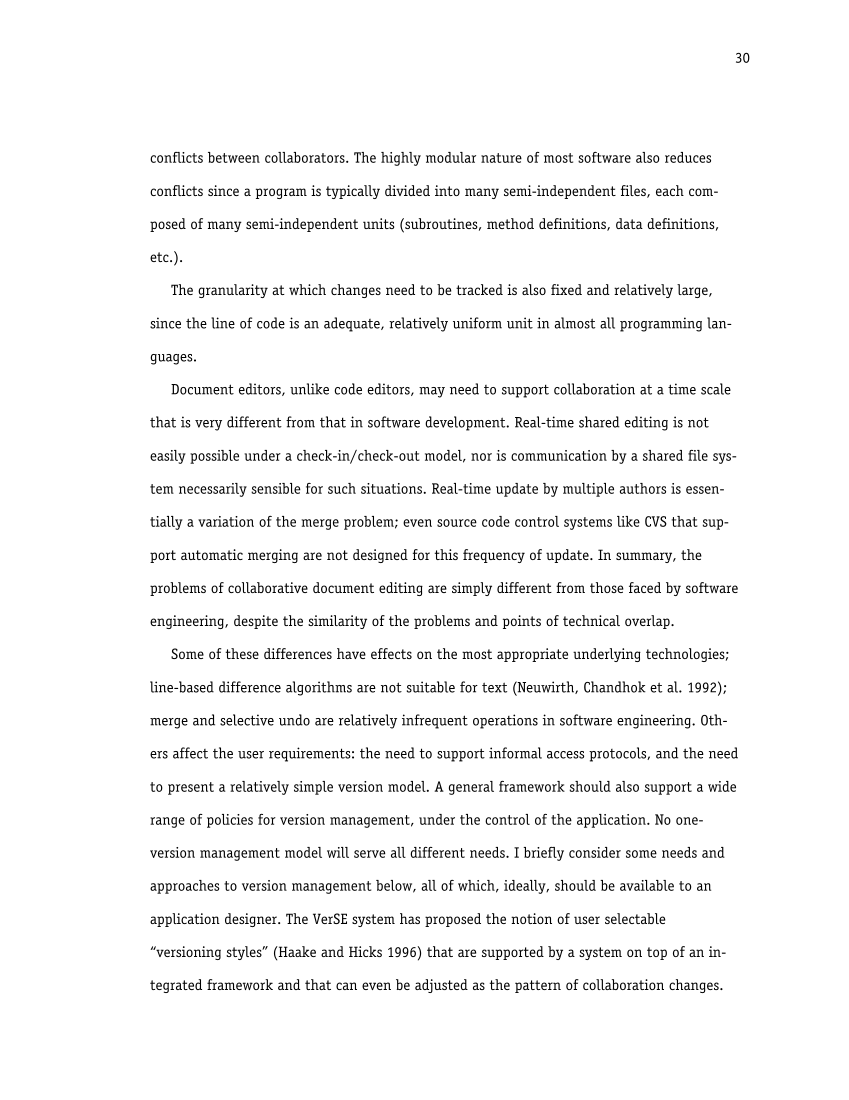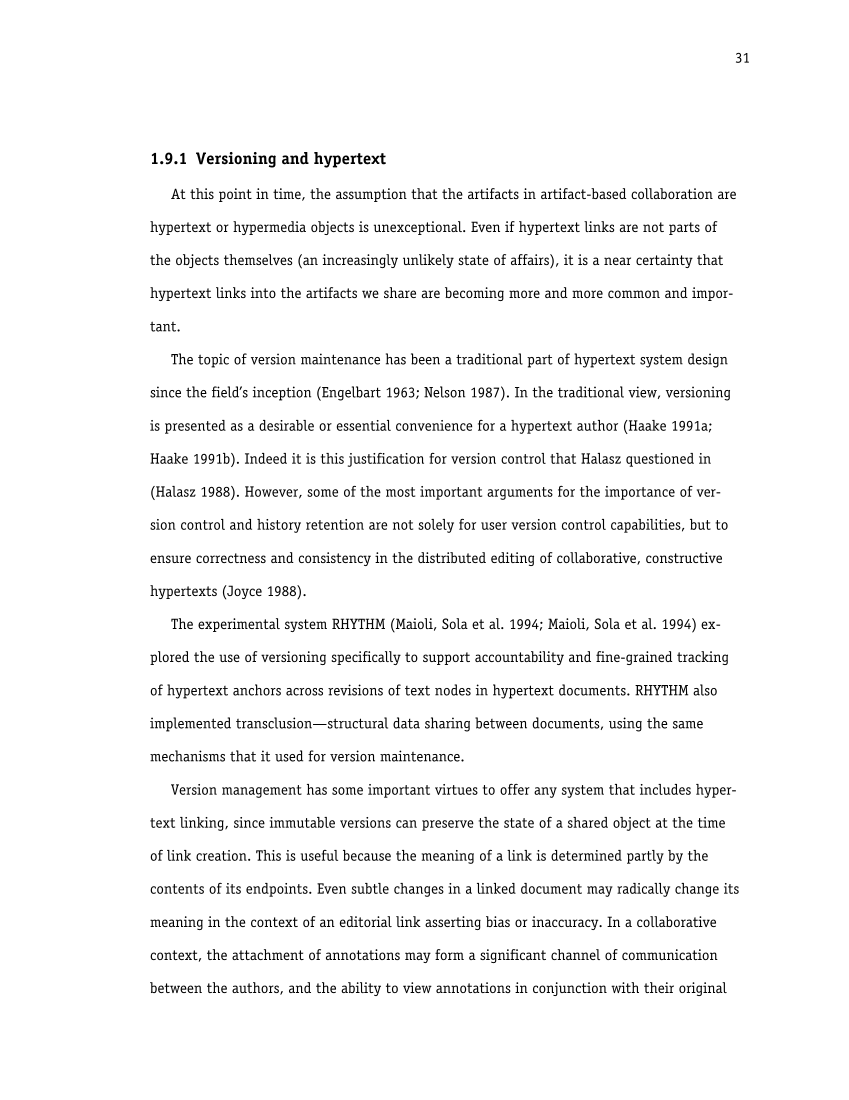30
conflicts�between�collaborators.�The�highly�modular�nature�of�most�software�also�reduces
conflicts�since�a�program�is�typically�divided�into�many�semi-independent�files,�each�com-
posed�of�many�semi-independent�units�(subroutines,�method�definitions,�data�definitions,
etc.).
The�granularity�at�which�changes�need�to�be�tracked�is�also�fixed�and�relatively�large,
since�the�line�of�code�is�an�adequate,�relatively�uniform�unit�in�almost�all�programming�lan-
guages.
Document�editors,�unlike�code�editors,�may�need�to�support�collaboration�at�a�time�scale
that�is�very�different�from�that�in�software�development.�Real-time�shared�editing�is�not
easily�possible�under�a�check-in/check-out�model,�nor�is�communication�by�a�shared�file�sys-
tem�necessarily�sensible�for�such�situations.�Real-time�update�by�multiple�authors�is�essen-
tially�a�variation�of�the�merge�problem;�even�source�code�control�systems�like�CVS�that�sup-
port�automatic�merging�are�not�designed�for�this�frequency�of�update.�In�summary,�the
problems�of�collaborative�document�editing�are�simply�different�from�those�faced�by�software
engineering,�despite�the�similarity�of�the�problems�and�points�of�technical�overlap.
Some�of�these�differences�have�effects�on�the�most�appropriate�underlying�technologies;
line-based�difference�algorithms�are�not�suitable�for�text�(Neuwirth,�Chandhok�et�al.�1992);
merge�and�selective�undo�are�relatively�infrequent�operations�in�software�engineering.�Oth-
ers�affect�the�user�requirements:�the�need�to�support�informal�access�protocols,�and�the�need
to�present�a�relatively�simple�version�model.�A�general�framework�should�also�support�a�wide
range�of�policies�for�version�management,�under�the�control�of�the�application.�No�one-
version�management�model�will�serve�all�different�needs.�I�briefly�consider�some�needs�and
approaches�to�version�management�below,�all�of�which,�ideally,�should�be�available�to�an
application�designer.�The�VerSE�system�has�proposed�the�notion�of�user�selectable
“versioning�styles”�(Haake�and�Hicks�1996)�that�are�supported�by�a�system�on�top�of�an�in-
tegrated�framework�and�that�can�even�be�adjusted�as�the�pattern�of�collaboration�changes.
conflicts�between�collaborators.�The�highly�modular�nature�of�most�software�also�reduces
conflicts�since�a�program�is�typically�divided�into�many�semi-independent�files,�each�com-
posed�of�many�semi-independent�units�(subroutines,�method�definitions,�data�definitions,
etc.).
The�granularity�at�which�changes�need�to�be�tracked�is�also�fixed�and�relatively�large,
since�the�line�of�code�is�an�adequate,�relatively�uniform�unit�in�almost�all�programming�lan-
guages.
Document�editors,�unlike�code�editors,�may�need�to�support�collaboration�at�a�time�scale
that�is�very�different�from�that�in�software�development.�Real-time�shared�editing�is�not
easily�possible�under�a�check-in/check-out�model,�nor�is�communication�by�a�shared�file�sys-
tem�necessarily�sensible�for�such�situations.�Real-time�update�by�multiple�authors�is�essen-
tially�a�variation�of�the�merge�problem;�even�source�code�control�systems�like�CVS�that�sup-
port�automatic�merging�are�not�designed�for�this�frequency�of�update.�In�summary,�the
problems�of�collaborative�document�editing�are�simply�different�from�those�faced�by�software
engineering,�despite�the�similarity�of�the�problems�and�points�of�technical�overlap.
Some�of�these�differences�have�effects�on�the�most�appropriate�underlying�technologies;
line-based�difference�algorithms�are�not�suitable�for�text�(Neuwirth,�Chandhok�et�al.�1992);
merge�and�selective�undo�are�relatively�infrequent�operations�in�software�engineering.�Oth-
ers�affect�the�user�requirements:�the�need�to�support�informal�access�protocols,�and�the�need
to�present�a�relatively�simple�version�model.�A�general�framework�should�also�support�a�wide
range�of�policies�for�version�management,�under�the�control�of�the�application.�No�one-
version�management�model�will�serve�all�different�needs.�I�briefly�consider�some�needs�and
approaches�to�version�management�below,�all�of�which,�ideally,�should�be�available�to�an
application�designer.�The�VerSE�system�has�proposed�the�notion�of�user�selectable
“versioning�styles”�(Haake�and�Hicks�1996)�that�are�supported�by�a�system�on�top�of�an�in-
tegrated�framework�and�that�can�even�be�adjusted�as�the�pattern�of�collaboration�changes.





























































































































































































